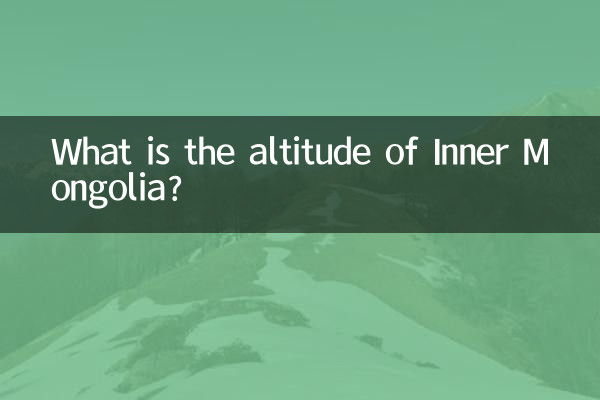What is the altitude of Inner Mongolia: revealing geographical features and hot topics
The Inner Mongolia Autonomous Region is located on the northern border of China, with a vast territory and diverse landforms. Its altitude varies due to differences in terrain, ranging from plains to plateaus, with a wide altitude range. This article will combine the hot topics on the Internet in the past 10 days, conduct a structured analysis of Inner Mongolia's altitude data, and discuss related hot topics.
1. Overview of Inner Mongolia’s altitude

The average altitude of Inner Mongolia is about 1,000 meters, but there are significant regional differences. The following is the elevation distribution of the main terrain:
| terrain type | Altitude range (meters) | representative area |
|---|---|---|
| plateau | 1000-1500 | Xilingol Plateau, Hulunbuir Plateau |
| plain | 200-500 | Hetao Plain, Tumochuan Plain |
| Mountain | 1500-2000 | Daxinganling, Yinshan Mountains |
| desert | 800-1200 | Badain Jaran Desert, Kubuqi Desert |
2. The hot topics on the Internet in the past 10 days are related to Inner Mongolia
Combined with recent hot topics, Inner Mongolia’s climate, tourism and new energy development have become the focus. The following is an analysis of the correlation between hot topics and altitude:
| hot topics | Related content | Altitude effect |
|---|---|---|
| extreme weather phenomena | Inner Mongolia cold wave warning | The temperature in the plateau area is lower and the temperature difference between day and night is large. |
| Grassland tourism peak season | Hulunbuir tourist arrivals hit record high | It is about 1,000 meters above sea level, suitable for summer vacation. |
| Wind power photovoltaic construction | Inner Mongolia’s new energy installed capacity breaks through | High-altitude areas are rich in wind energy resources |
3. The impact of Inner Mongolia’s altitude on life and ecology
Altitude directly affects climate, vegetation and human activities. The plateau characteristics of Inner Mongolia make it a unique ecological barrier:
1.climate aspect: High altitude results in lower average annual temperatures and precipitation concentrated in summer, forming a typical temperate continental climate.
2.Distribution of agriculture and animal husbandry: The Hetao Plain with a lower altitude is an important agricultural area, while the plateau is dominated by animal husbandry.
3.ecological significance: As the core area of the northern sand control belt, elevation gradient changes have shaped diverse ecosystems.
4. In-depth interpretation of the latest hot events
The recent ecological management project of Alxa League in Inner Mongolia has attracted attention. The area has an average altitude of 1,300 meters and is difficult to manage:
| Project name | Altitude range | Governance measures |
|---|---|---|
| Helan Mountain Ecological Restoration | 1400-2000 meters | Mine renovation, vegetation restoration |
| Ulan Buh desert border | 1050 meters | grass grid sand fixation |
5. Travel Advice and Altitude Adaptation
For tourists planning to travel to Inner Mongolia, please note the altitude changes:
1.health tips: The altitude of most scenic spots is within the adaptable range, but sensitive people need to pay attention to altitude sickness.
2.best route: It is recommended to gradually go to the plateau area from Hohhot (1000 meters), which is at a low altitude.
3.Season selection: July-August is the best tourist season, when the climate in the grasslands at higher altitudes is cool and pleasant.
Conclusion:
Inner Mongolia's altitude characteristics have shaped its unique natural and cultural landscapes. It can be seen from recent hot spots that scientific understanding of plateau areas has become increasingly important in the context of climate change and green development. Understanding elevation data not only helps with trip planning, but is also key to understanding regional development strategies.

check the details

check the details